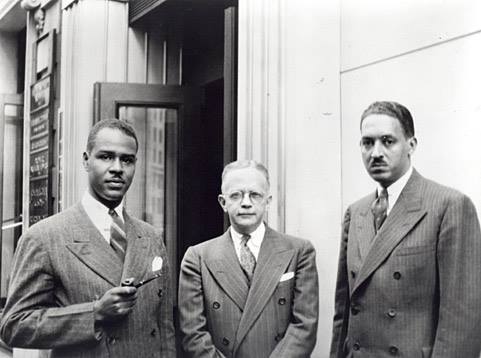
11 Feb THURGOOD MARSHALL COMES TO SOUTHEASTERN OKLAHOMA Part 2
THURGOOD MARSHALL COMES TO SOUTHEASTERN OKLAHOMA: The trial of W.D. Lyons in Hugo, Oklahoma
PART TWO…
THE ARREST AND CONFESSIONS OF W.D. LYONS
On the night of January 11, 1940, W.D. Lyons left his mother-in-law’s home to go into the woods to get a drink of illegal whiskey, which was hidden there. On his way back he ran into Ennis Aikens, and the two men noticed several police cars drive up to the home. When Lyons approached the home he was met by two men with drawn revolvers. The two men arrested Lyons and since they didn’t have handcuffs, they bound his hands behind his back with his belt, and started toward the jail.
About three blocks from the jail one of the men, Reasor Cain, broke off a piece of one-inch board lying on the street and struck Lyons on the head with it. Both men began to kick Lyons and threatened his life by telling him they were going to burn him and kill him unless he “confessed”. About a block from the jail the men “bumped” his head against a tree, and when they did finally reach the jail, the jailer on duty hit Lyons in the mouth with large ring of jail keys.
At the Jail, Lyons was taken to a room and more officers, including the sheriff himself appeared and began to beat him. He received multiple injuries to his face, head, and all of his other extremities. One of the officers used his cowboy boots to kick Lyons in the shins to the point that most of his skin was literally removed by the strikes. By the end of the beating he could barely walk, but had maintained that he had no idea what the officers were talking about. Lyons was taken to his cell, but his ordeal was far from over, the poor black sharecropper had yet to meet the Governor’s man, Vernon Cheatwood.
Eleven days later the still bruised and battered W.D. Lyons was removed from his cell and taken to an office in the courthouse at about 6:30 in the evening. As he was being escorted through the courthouse, a man stepped up and stopped the officer that was leading Lyons. The man instructed the officer not to hit Lyons in the head because, “I know how to get it out of him when we get him up here”. That man was Special Investigator Vernon Cheatwood.
Lyons was handcuffed to a chair, and Cheatwood beat him with a blackjack on his knees, hands, arms, and legs. The other officers in the room beat him as well, stepping in for each other as the men would tire. The men would take Lyons out of the chair and hold him over the table while Cheatwood would beat him in the back of the head with the blackjack, then put him back in the chair and resume beating him on the arms and legs again. All the while they would yell questions and say, “You killed those people didn’t you? You goddamned black son-of-a-bitch, you are going to tell me before I turn you loose!”
About two-thirty in the morning the officers brought in a pan of bones and teeth, blackened and charred, and placed them in Lyons’ lap. Cheatwood told Lyons they were the recovered from the Rogers’ home.
“Now, look at them bones, Boy. Look at ’em. Them’s the bones and teeth of Mrs. Rogers and that little baby you done killed. Don’t look away, nigger. You look at your handy work. You look at what you did to them people,” Cheatwood said.
They took the bones out of his lap ad would beat him some more. The officers repeated the process for another two hours when Lyons finally spoke. At approximately 4:30 A.M. W.D. Lyons “confessed” to killing the Rogers family because they “beat me and beat me until I couldn’t stand no more, until I gave into them and answered the questions they demanded.”
Lyons was led away to his cell while the exhausted officers sat down for some breakfast and coffee. Feeling replenished the officers called upon Lyons again and was brought from his cell and placed into a patrol car. The men all headed toward the Rogers homestead in Fort Townson. Cheatwood rode in the same vehicle as Lyons, and during the drive he told Lyons they were taking him to Fort Townson to kill him, and that he should say his prayers. When they arrived at the property the officers took Lyons up to the ruin and instructed him to tell them again that he had in fact done it. When he hesitated, the officers threatened to torture him with a pickaxe. This time Lyons put up no resistance and told the men that he had been the one.
Later that afternoon the caravan of horribles and their prey arrived at the state penitentiary in McAlester. There Lyons and the men were led to the office of the warden, Jess Dunn. While in the presence of the warden, Lyons was asked if he was the one that murdered the Rogers family. There is no question that Dunn more than anybody knew that Lyons had not been the murderer, he had personally investigated the confession of a white prisoner just weeks before.
Lyons initially denied any involvement. One of the officers present, Van Raulston began beating Lyons with a blackjack, saying, “You either answer our questions or you get treated like you was before.” Lyons did not hold out long and eventually cracked.
He later recounted: “He beat me awhile longer, until I couldn’t stand it anymore, I was already hurting from – already hurting from that last night beating. I hadn’t had any sleep since that Sunday night…. Mr. Van Raulston asked me was I ready to answer his question and I said yes, and Mr. Dunn he sent and got a stenographer and Mr. Dunn and Mr. Van Raulston was telling me how the crime happened.”
Warden Jess Dunn fed the information to the beaten Lyons. He would have the best idea of how the murder had actually happened because he had gotten that information from the prisoner that had confessed prior to Lyons. Dunn had Lyons sign a confession statement and then had him taken down to the “death row” cell and left him in the cell with the electric chair. As Dunn locked the door he boasted that “he had done sent down thirty-nine men”.
A few days later it was reported that Lyons confessed yet again to some guards at the penitentiary. On this occasion he did not sign a statement, and only the officers were present to hear this confession. During the trial the state would deny that any harm ever came to W.D. Lyons and that all of his confessions were voluntarily given. They would come to find a very formable opponent in the form of Thurgood Marshall. Marshall would not only challenge the officer’s account, but the minds and to some extent the hearts of an entire community with eloquence and courage.
A GALA DAY
The trial began on Monday, January 27, 1941, more than a year after the death of Mr. and Mrs. Rogers and their four-year-old son, and the arrest of W.D. Lyons. The delay of over a year before trial spoke volumes to Marshall. He would note that when a black man was accused of a crime in the Jim Crow south justice was just as often swift as it was brutal. The fact that the state waited so long to bring the black sharecropper to trial cemented Marshall’s belief that Lyons was a scapegoat for the Governor and other state officials.
The court came to order that morning. The Honorable J.R. Childers took to the bench, chomping and puffing on a large lit cigar. County prosecutor Hotaan Horten announced ready, and the Judge began the proceedings. The courtroom was packed. People from all over the county had come to see the trial and this mysterious negro form New York. Judge Childers announced that this case involved “two nationalities”, white and black, and he cautioned those in attendance that he didn’t “want no trouble”.
Also in attendance during the trial were school children, brought to the courthouse by their teachers. Noticing this, the judge announced that this was a “gala day”. Marshall would recount in a letter to Walter White, “Imagine it, a negro on trial for his life being called a ‘gala day’.”
The jury was eventually selected. Many of those called claimed that they could be “as fair to a negro, as a white man”. Several refused to sit because they acknowledged they had fixed opinions about the case, and other were let go because of their view on capital punishment. Eventually an all-white jury was selected, which Marshall described as “lousy”. The court heard opening statements and recessed for the day.
The second day began with the state calling Jess Dunn to testify about the confessions. As Marshall said, “That’s when the fireworks started. Marshall moved to have the confessions suppressed, claiming that they came as a result of torture. The court excused the jury from the room and began to take testimony regarding the confessions.
Each of the officers that were in attendance at one time or another when Lyons was questioned took the stand. To a man, each one testified under oath that Lyons was not struck or injured in any manner. Marshall skillfully cross-examined each man, locking them into their testimony, and highlighting their strong denials.
Then County Prosecutor Horten called W.D. Lyons to the stand. The poor black sharecropper, shuffled to the stand carrying the slack chain from his shackles in his hands before him. He sat and looked at the prosecutor.
“You claim that these men beat you with a blackjack, straps and sticks?”
“Yes, Sur.”
“Each of these men, upstanding members of the community, sworn officers all, have denied this.”
“Yes, Sur.”
“Yet you, and you alone, claim that this happened. And, you have no witnesses to support these claims.”
“Well, Sur, you seen it, you was there.”
Horten enraged turned to the judge and denied that he was present. He turned back to Lyons and insisted that he take back his words. Lyons would not relent, he continued to claim that the prosecutor was indeed present. His face reddened the prosecutor jabbed his finger at the witness and demanded that he recant what he had said.
Lyons looked Horten right in the eyes and said, “Oh yes, you were there.”
The astonished prosecutor momentarily broke character and stammered, “Why….I stopped them from whipping you!”
The courtroom immediately erupted in a noisy buzz, and Judge Childers began to bang his gavel shouting for, “Order! I’ll have order in this court!” Marshall jumped to his feet as the judge was rapping his gavel down hard on the bench. He wanted to make sure the record was clear that Horten had just conceded that in fact he had been present and witnessed the “whipping” of the defendant.
Those gathered in the courtroom were stunned into silence. Never before had any of them seen a black man standing up in court ad talking to a powerful white man without deference, and all the while looking them right in the eyes. But Marshall wasn’t done yet.
Cheatwood had already taken the stand and upon cross-examination had claimed that not only had he not beaten Lyons, he didn’t even own a blackjack or any kind of club. Marshall called a hotel clerk to the stand. The clerk testified that on the evening of Lyons’ interrogation, Cheatwood told the clerk, “Go up to my room and get me my nigger-beater.”
Next Marshall called E.O. Colclasure, the father of Mrs. Rogers. Colclasure testified that Cheatwood showed him his blackjack and said, “I beat that boy last night for, I think six-either six or seven hours…I haven’t even got to go to bed last night.” Then Marshall called Mrs. Vernon Colclasure, the sister-in-law of Mrs. Rogers. She testified that Cheatwood showed her the blackjack and also stated he beat Lyons “from his knees on down”.
When the court recessed, Marshall was greeted in the halls by spectators that told him that they enjoyed the way the case was going and that they didn’t believe Lyons was guilty. As the officers exited the courtroom, Marshall observed that those same white people were giving the officers a “piece of their mind”, and didn’t appear to appreciate the fact that they had taken the stand and obviously lied. The victory was short-lived however.
Judge Childers did throw out Lyons confession, but only one. Childers ruled that the confession taken at the penitentiary was not proven to be as a result of torture and was in fact voluntarily given. Marshall, never expecting a full victory, took the ruling in stride, noting that he had made a “very good record”.
The jury was brought back into the courtroom and the trial would resume. Over the course of the following days Marshall would cross-examine the officers, at times bringing them to a boiling anger. He would later remark in a letter to Walter White, “Boy did I like that, and did the negroes in the courtroom like it. You can’t imagine what it means to these people down there who have been pushed around for years to know that there is an organization that will help them. They are ready to do their part now. They are ready for anything.”
The case came to a close and the jury went into deliberations. It wasn’t until five and a half hours later that they returned with a verdict. They found Lyons guilty, and delivered a sentence of life. Marshall took this as a sign that the jury surely felt Lyons was innocent, but could not bring themselves to actually make that finding.
However, many of those that witnessed the trial from the gallery did not share the juror’s sentiment. Many citizens told reporters that they felt Lyons was not guilty, and that the police had set him up. One of those that spoke out was Mrs. Rogers’ grieving father, E.O. Colclasure. He spoke to reporters and said that it was his belief that Lyons was not his daughter’s murderer, and that the prosecutors and police had conspired to frame him. So moved by the trial and Thurgood Marshall, Mr. Colclasure joined the NAACP and became the first ever chapter president in Southeastern Oklahoma.
THURGOOD MARSHALL would return to New York, confident that he would prevail on appeal. Unfortunately, he would not. The Supreme Court took up the Lyons case, but refused to throw out the second confession and affirmed the conviction. The Lyons case in the end was a loss for Marshall, but it would be one of the few. He would go on to great victories in the Supreme Court on the behalf of the NAACP, including Brown v. Board of Education, forever striking down the “separate but equal” decision in Plessy v. Ferguson. He would also become the first African-American to be appointed to the United States Supreme court, and exemplified the words of his mentor: “A lawyer is either a social engineer, or a parasite on society.”
W.D. LYONS was sent to the Oklahoma State Penitentiary. For years Marshall would advocate for early parole for Lyons, often sending his own money to Lyons. After serving twenty years of a life sentence, Lyons was paroled in February of 1961. His life after parole remains unknown.
GOV. LEON C. PHILLIPS remained in office until 1943. He was charged with taking a bribe, and tried twice, eventually being acquitted. He retired to his farm near Okemah, Oklahoma and practiced law until March 27, 1958, when he passed away from a massive heart attack.
WARDEN JESS DUNN was shot and killed on August 10, 1941 during a prison break at the Oklahoma State Penitentiary in McAlester. Dunn was honored the following year, when the annual prison rodeo was held in his name. Unbelievably, he was further honored by the Department of Corrections in 1980, when it named a newly built correctional facility near Taft, Oklahoma, the Jess Dunn Correction Center. It is a shameful thing that the largest department in the State of Oklahoma chooses to honor the name of a racist torturer that is at least partially responsible for framing an innocent man and releasing a murderer from custody.
CONCLUSION
For me the most impressive thing about this story is the actions of E.O. Colclasure after the proceedings. The same man who lost his daughter, son-in-law and grandson was so affected by the argument and aura of Marshall, that he joined the NAACP. I wrote about Marshall’s fear, and that particular photograph that always stuck in his mind. That is true account. Marshall spoke about that particular picture and the fear he felt when he saw the gleeful indifference in those children’s eyes.
For Marshall to change the hearts and minds as he did in the Lyons case is an extraordinary thing. Sure he didn’t change all the hearts and minds, probably not even a majority of the citizens of Choctaw County, but he understood the power of changing just one or two. This was not a frustration of his, but rather a strategy. Often it is forgotten that Brown v. Board of Education (Marshall’s greatest victory) was actually a compilation of four cases and about twenty years of work. Hardwood grows slowly. Marshall understood this and as a result of his efforts he was able to spearhead great changes in our justice system and the country as a whole.
Finally, Thurgood was a writer, and he wrote letters back to Harlem about his trip to Oklahoma. Tomorrow I will post those letters.






No Comments